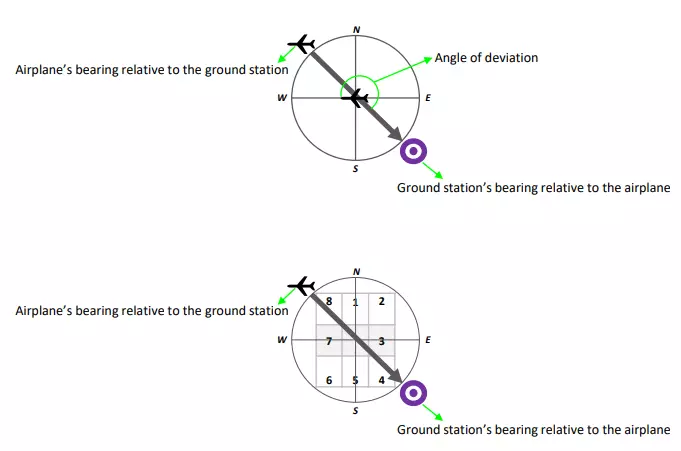 Free Cut-e Pilot Test: Spatial Orientation, Monitoring & More
Free Cut-e Pilot Test: Spatial Orientation, Monitoring & More
The cut-e Pilot Test is a psychometric assessment designed to evaluate the essential skills required of pilots. Widely used by leading airlines and flight schools, such as Qantas Pilots Academy, Lufthansa, and EasyJet, it is a crucial screening tool to identify aspiring pilots with the necessary aptitude.
The cut-e Pilot Assessment includes challenging aptitude tests, such as the cut-e spatial orientation pilot, monitoring, and complex control tests. To enhance your performance, it is beneficial to be familiar with the test questions and practise similar tests. Doing so can significantly improve your score and boost your chances of success.
✈ On this page, sample questions and expert tips will help you prepare for the cut-e Pilot Test. All samples were selected from our comprehensive cut-e Pilot Test preparation.
Exciting update! Our PrepPack now includes the Motion Challenge Game + 3 new versions of the Multitasking Game.
- New! Motion Challenge Game & 3 Multitasking Game Versions
- Spatial Orientation Tests (Gyro & RBI)
- Reaction Time Practice
- Monitoring Ability Practice
- Sustained Attention Practice
- Working Memory Game & Guide
- Cut-e Logic Tests
Inductive & Deductive Tests - Cut-e Numerical Tests & Guide
- Behavioral Pilot Tests & Guides
Personality & Integrity Tests - Verbal Reasoning Tests & Guide
- Pilot Interview Preparation
What Is the Cut-e Pilot Test?
The cut-e Pilot test assesses essential competencies of airline pilots, such as multitasking, eye-hand coordination, spatial awareness, and arithmetic abilities.
The cut-e pilot test comprises a battery of up to 12 mini-tests, each evaluating a different cognitive or behavioral quality. The number of mini-tests differs between airline companies and flight schools. All of the cut-e tests are taken in the MapTQ Online Platform.
These cut-e tests, or Aon tests, are pretty challenging since most of them deduct points for wrong answers and have strict time limits.
Airlines that use the cut-e assessment include: Qantas, Leading Edge, Aer Lingus, Cathay Pacific, EasyJet, Fly Dubai, Ryanair, NATS, Lufthansa, and the British Airways Cadet Programme (Speedbird)
Cut-E Pilot Spatial Orientation Test
The Pilot cut-e Spatial Orientation Test, or the GYRO and RBI Test, involves identifying aircraft position and attitude using the GYRO and RBI indicators. You will have 3 minutes to complete the test.
You will see a dashboard featuring a gyrocompass (GYRO) to show your flight direction and a radio compass (RBI) to indicate the location of a non-directional beacon. Your task is to determine the aircraft's flight direction and location. To do this, you must mentally rotate the RBI to identify the position of the non-directional beacon.
Here is a cut-e spatial orientation sample question:
Sample Question #1
Select the aircraft’s flying direction, indicated by the GYRO, and the zone indicated by the RBI.
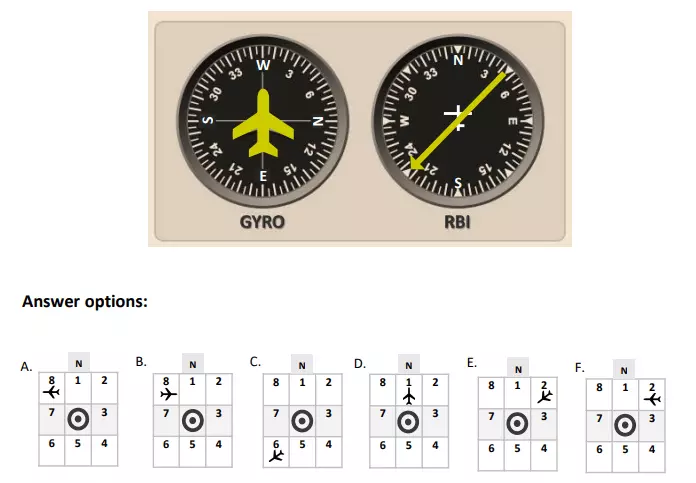
TIP: To help you make the correct calculations, imagine that the RBI turns the same way as the aircraft.
Cut-E Pilot Reaction Speed Test (scales rt)
The Cut-E Reaction Speed Assessment measures your speed in processing and responding to visual information.
During the test, you will be presented with pairs of geometric shapes. Your task is to quickly determine whether the shapes are identical. You will have 3 minutes to complete the test.
Here is an example of a reaction speed question, taken from our full cut-e pilot test preparation:
Sample Question #2

TIP: Pressing the key when the shapes are different will be considered a mistake and will reduce your score.
Cut-E Pilot Monitoring Test
In the pilot monitoring test, you’ll be shown varying numbers of moving balls. Your task is to count the balls as quickly as possible. Each correct answer will increase the difficulty. Overall, you have 2 minutes to answer as many questions as possible.
Here is an example of a monitoring test question taken from our Cut-e Pilot Test Preparation:
Sample Question #3
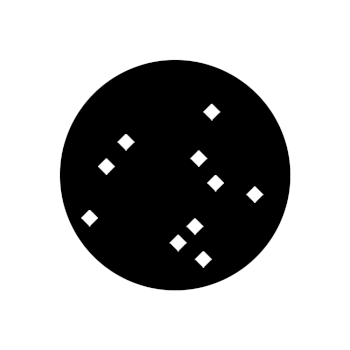
TIP: Group the balls into pairs of four, then count the number of groups and multiply them by four.
Cut-E Pilot Multitasking Test
The Cut-E Multitasking Test assesses your ability to perform tasks quickly and simultaneously.
You will be required to complete three tasks at the same time –
- Task I – on the center of the screen, you will be presented with aircraft that fly from left to right.
Your task is to bring as many aircraft as possible to the runway. - Task II – On your screen's top right corner, you will be presented with changing equations.
Your task is to verify that the equations are correct. - Task III – on the bottom right of your screen, you will be presented with a sequence of seven letters.
Your task is to check if any of the letters appear twice.
You will have 5 minutes to complete the task.
TIP: Dedicate a few seconds to each task, while paying enough attention to the other two.
Cut-E Pilot Complex Control Test (wingChallenge)
An assessment of your hand-eye coordination.
You will be presented with a simulation in which you navigate through a rotating cylindrical tube.
Your task is to fly through the tube and avoid the obstacles that come your way.
You will have 3 minutes to complete the task.
TIP: You can control your speed and adjust it to your convenience. Although you have limited time, you can start the task at medium speed and once you figure it out, gradually increase to a faster and harder mode.
Cut-E Pilot Inductive Logical Thinking Test
The Cut-e Inductive Logical Thinking Test assesses your ability to recognise and apply rules and patterns.
You will be presented with two sets of grids. In the upper set, each grid has an assigned colour. Grids marked with the same colour are a part of the same group.
Your task is to recognise the patterns of each colour group and assign the unmarked grids to the group they belong to.
You will have 12 minutes to complete 12 tasks.
Let's look at an inductive logical thinking sample question:
Sample Question #4
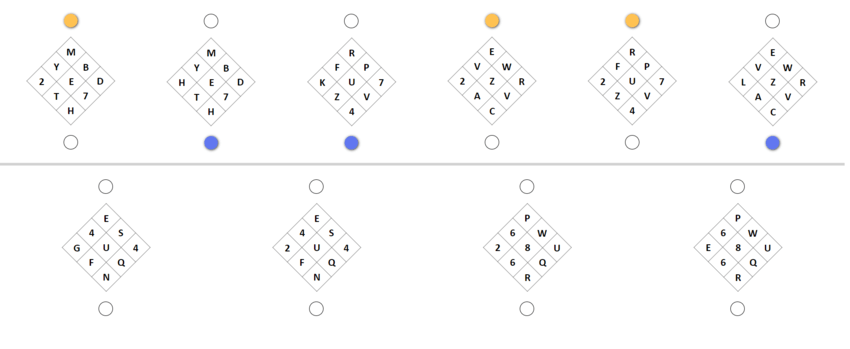
TIP: The pattern of each group can be manifested in every variable within the grid. Thus, you need to pay close attention to every fine detail – the arrangement of the numbers and letters, the quantity of each character, etc.
Cut-E Deductive Logical Thinking Test
The Cut-E Deductive Logical Thinking Test assesses your ability to learn, infer, and apply new information.
You will be presented with a grid that contains a series of symbols and one cell with a question mark. Your task is to identify which symbol should replace the question mark so no two identical symbols occupy the same column or row.
You will have 6 minutes to complete as many tasks as possible.
Here is a deductive logical thinking sample question:
Sample Question #5
What symbol should appear in place of the question mark?
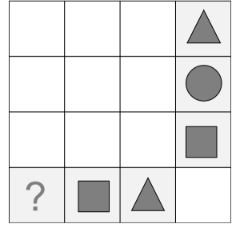
TIP: A symbol can appear only once in each column or row. Therefore, you need to be sure that the symbol you choose as missing is not violating that rule and does not appear more than once.
Cut-E Applied Numeracy Test (scales tmt)
The Cut-e Numerical Test assesses numerical reasoning and calculating skills in four areas: Translation of Units, Rule of Three, Percentage Calculation, and Areas and Spaces.
You will be presented with an text passage, followed by a multiple-choice question. Your task is to make the calculations needed to reach the correct answer.
Let’s view an applied numeracy sample question:
Sample Question #6
The total cost of an electric bill is $318.00. If 6% tax, which is added to the cost of the electricity, is included in the $318.00, how much did the electricity cost before tax?
TIP: Not all the information presented is relevant to the question. So, first, you need to sort through the paragraph to determine which data items are necessary to solve the problem.
Cut-E Verbal Reasoning Test (scales verbal)
The Cut-E Verbal Reasoning Test assesses your ability to understand, analyze, and interpret textual information.
You will be presented with six tabs of text, each followed by a statement. Your task is to determine if the statement is true, false, or 'cannot say' based on the information within the different tabs.
You will have 12 minutes to complete 49 tasks.
Let’s view a verbal reasoning sample question:
Sample Question #7
Below are six tabs containing information about a business, followed by a statement. Read the statement, then look for the relevant information inside the tabs to help you label the statement as true, false, or indeterminate.
Structure
Shareholders – shareholders are people who invest their own funds in a company. A shareholder is usually an outside investor, but some management positions hold shares in the company as an incentive to put more effort into it. Employees from management positions cannot be hired as managers in the subsidiary organization too, even if it's a non-profit organization, to avoid a conflict of interest.
Management – this division is comprised of the CEO, the sales representative, and team leaders and secretaries who have worked in the company for three years or more.
Materials – this division is comprised of engineers, truckers, lab researchers, assembly line workers and tech support. During the high season period, the company hires a fair amount of freelancers to help with the lab research. After the season ends, their contract is terminated. The cleaning staff is an outside company that is getting paid to clean the organization’ facilities. Their actions are supervised by the safety engineer.
The company will open a bid for the audit committee position every year. The chairman must be someone with no substantial affiliation to the company, not an employee, not from an employee's family or future family, and certainly cannot be someone who took part in the organization in the past 5 years.
Responsibilities
The cleaning staff must have three employees on "standby" to respond to any of the safety engineer’s calls.
All employees must work 9 hours a day, and no more than 13 hours in overtime.
The CEO may allocate 12% of the company's yearly revenue for research and development.
For charity outreach, the company will send three employees to Manchester's soup kitchen for a full workweek.
Pipelines – this service is provided by the materials division representatives and not someone who specializes in plumbing, thus it's one of the least profitable products the company offers due to bad reviews.
Natural gas products – a seasonal product operated by seasonal employees only. The revenue from these products is allocated to the subsidiary company.
Electricity usage efficiency – this service is one of the most profitable products/services the company offers. This service is scheduled through sales and is provided by the engineers.
The company's research team is trying to initiate a new business strategy and provide one additional product – printed 3-D building blocks. This is not a product yet, but it will be in 2029.
The management division is located in the northern business center of Manchester, whereas there are three active locations around the country: The pipeline manufacturing factory is located in the industrial area of South Manchester. The natural gas product is located on an oil platform on the shores of the country. The electricity usage efficiency is a service that does not require a plant but does require an office with all the right facilities. This office is located next to the management offices.
Once a year, the company rents a research lab for three months in a different location.
The cleaning staff has its own cabin for sleeping outside the pipeline factory.
The company owns a suite of offices in downtown Manchester. Those offices are rented to a third party at the moment but can be cleared out within 14 days from the moment the company notifies the third party.
All plants must be running 24 hours a day, seven days a week.
Assembly line workers work in shifts of 8 hours. Within their shifts, workers must melt 850 lbs. of steel and manufacture 107 deluxe pipelines altogether.
The CEO, the head of engineers, and the employee in charge of the cleaning staff must convene once a week for a site-wide operational evaluation.
The delivery team, which is comprised of the truckers, must report to the head of sales every 12 hours.
The Board of Directors is elected by the shareholders and is assigned to monitor the company's activity as a whole.
The Board of Directors hires the CEO themselves, and they have the power to fire him if 10% of the management agrees to it.
The Board of Directors convenes every 75 days and discusses the CEO's performance every 100 days.
The Board of Directors has the right to allocate up to $100,000 in bonuses every year. Higher amounts should be authorized by the shareholders' general assembly.
Every director can be fired by the shareholders' general assembly, and once every five years 40% of them must be replaced by new directors.
No management employees are allowed to be in the company's Board of Directors.
The board must consist of at least 33% females, at least 20% males and at least 12% university graduates.
The company is willing to provide any document regarding electricity and pollution stats for the past year to any inquiring party. The document will be issued by the weekly evaluation committee.
With regard to yearly revenue, the board will not provide any reports to any party other than the shareholders.
The company will not provide any reports regarding its missions, schedule, or the profit division of products and services to any third party.
Shareholder reports should be provided by the CEO to the board, and the board will disseminate the reports to the shareholders.
Once every five months the company will deliver a report to the government addressing issues required by the commissioner. However, if any of the information could potentially hurt future revenue or violate privacy, the report won't be provided without a warrant.
The company will receive tax refunds of 12% if they invest at least 42 weekly hours in a known non-profit organization or at least 60 weekly hours in any other charity work. The 12% tax refund may accumulate into millions a year, thus it is a profitable strategy. The company has been receiving refunds for the past three years.
Statement: All the cleaning staff is on standby every single moment.
TIP: To find the relevant information, you need to go through all the different tabs, and you must submit your answer while you on the correct tab; otherwise, you will lose the points, even if the answer is correct.
Cut-E Work-Related Behaviour
An assessment of your workplace behaviour and preferences.
You will be presented with sets of three statements regarding your personal traits and tendencies, and six points to distribute.
Your task is to divide the points according to how accurately each of the statements best describes you.
Tip: You can place all six points on one statement or divide them between the statements as you think best describes you.
TIP: You can place all six points on one statement or divide them between the statements as you think best describes you.
Cut-E chatAssess
ChatAssess is an assessment of your work-related behaviour and judgment through a gamified situational judgment test (SJT).
You will be presented with a chat simulation with incoming messages from customers and colleagues.
Your task is to respond to the messages by choosing from the given options or typing an answer in your own words.
You will have 20 minutes to answer all messages.
Let’s see how chatAssess looks –

TIP: When choosing your reply, you need to consider three factors – the person’s request, position, and ranking.
Cut-E Pilot Working Memory (Smartpredict GridChallenge)
An assessment of your working memory, focus, and attention.
You will be presented with a grid containing a series of dots, with one of them highlighted, followed by an unrelated question regarding the symmetry of a simple diagram. Then, you will be presented again with the grid, and another highlighted dot, followed by another diagram question, and so on.
Your task is to memorize the order and positions of the highlighted dots.
You will have 9 minutes to complete 9 tasks.
Let’s look at a working memory sample question –
TIP: to better remember the position of the dots, you can verbalize their location. For example, say, “The upper dot one the 3-dot group on the right.”
Get Ready to Ace Your Cut-e Pilot Test – All-in-One Prep Pack
Stand out in the recruitment process and secure your future as a pilot with JobTestPrep’s comprehensive practice kit. Our Cut-e pilot test practice includes:
- Spatial orientation training with GYRO and RBI
- Full-length tests for verbal, numeracy, inductive, and deductive sections
- Personality test, chat simulation, and expert interview guide
★ 4.6 (85 reviews) | 448 already enrolled
Cut- E Pilot Test FAQs
A pilot assessment test is a psychometric evaluation of the essential skills, aptitude, and competencies needed for aircraft pilots. The cut-e Pilot Assessment is a widely used psychometric test for this purpose.
The pilot aptitude consists of several mini-tests that assess skills like multitasking, hand-to-eye coordination, spatial awareness, monitoring abilities, complex control, numerical and verbal reasoning, and inductive and deductive thinking.
Many flight schools and large airlines companies use the cut-e pilot test; among them are L3 Flight Academy, Aer Lingus, EasyJet, Ryanair, L3/CTC, FlyDubai, Lufthansa, Swiss (DEC), Thai Airways, Norwegian, and Etihad.
The cut-e pilot assessment is demanding, requiring a high score to pass. To excel, it's essential to prepare thoroughly and become familiar with each section’s challenges.
Our PrepPacks are designed to help you succeed on the cut-e pilot test, offering comprehensive guides and test simulations with detailed explanations.
Create Your Custom Assessment Prep Kit
Job-seeking can be a long and frustrating process, often taking months and involving numerous pre-employment tests and interviews. To guide you through it, we offer a Premium Membership.



